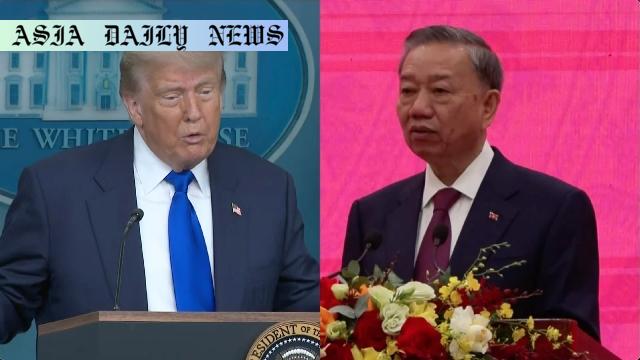Vietnam Trade Deal secures new tariffs and access terms, marking a strategic US victory in trade negotiations before the deadline.
Vietnam has committed to a trade deal ahead of the June 9th deadline.
US levies a 20% tariff on Vietnamese goods as part of the deal.
Vietnam opens market access for American products, easing trade barriers.
Trump warns of 40% tariffs on re-routed Chinese goods via Vietnam.

Introduction to the US-Vietnam Trade Deal
The United States has successfully reached a critical trade agreement with Vietnam, as announced by President Donald Trump. This comes just days before the impending expiration of the June 9th deadline on ‘reciprocal tariffs,’ threatening higher levies on trade partners that fail to secure agreements with Washington. The agreement marks a significant shift in Vietnam’s import policies, promising ‘total access’ for US products and reduced tariffs on American exports. For Vietnam, this renders its goods subject to a 20% US tariff, which is noticeably lower than the hostile 46% rate applied earlier this year.
Details of the Trade Agreement
President Trump delivered the terms of the deal through social media, emphasizing that the agreement reflected a historic opening of Vietnam’s markets. A standout element of the deal is the imposition of a 20% levy on all Vietnamese goods, raising questions about the inclusion of a pre-existing 10% global tariff. Furthermore, the agreement includes a stern warning from the President—goods originating from other countries, particularly China, that are routed through Vietnam to evade higher tariffs will face a punishing 40% duty.
Shift in Global Trade Dynamics
The US-Vietnam agreement places a spotlight on the broader shifting dynamics in global trade under the Trump administration. Vietnam holds the fourth-largest trade deficit with the US, following behind Mexico, the EU, and China. As Washington continues its tough negotiation tactics, speculation mounts on how other major trade partners might respond. The UK has already signed a definitive agreement, and both India and China are reportedly in rapid negotiations in an effort to sidestep punitive tariffs.
Implications for Vietnam and US Strategy
This trade deal has implications beyond the immediate bilateral benefits. For Vietnam, the agreement offers a tempered tariff rate while ensuring unimpeded access to critical US markets. For the United States, it reinforces the administration’s focus on bilateral trade agreements as a method to reduce trade deficits while simultaneously asserting pressure on countries such as China. With massive repercussions for global trade policy, this deal sets the stage for a more assertive US approach to subsequent trade discussions in Asia and beyond.
Looking Forward
The US-Vietnam trade deal is a critical piece in the Trump administration’s larger trade puzzle. With the June 9th trade deadline approaching, the question remains whether other nations will make concessions significant enough to secure agreements with Washington. Trump’s tough rhetoric on imposing levies as high as 30-35% on Japanese exports highlights the ongoing volatility and pressure inherent in these negotiations. As the world watches, Vietnam’s willingness to adapt might provide a roadmap for other nations navigating this challenging trade climate.
Commentary
Strategic Impact of the US-Vietnam Trade Agreement
The US-Vietnam trade deal is a fascinating reflection of current global trade realities, drawing attention to the evolving nature of international commerce under a protectionist agenda. By setting a 20% tariff on Vietnamese products, the US has adopted a moderated approach compared to the previous 46% rate, signaling strategic leniency to foster bilateral cooperation while aggressively curbing evasive practices involving transshipment of Chinese goods through Vietnam. This intricate balancing act suggests a nuanced application of pressure, rather than unsubtle economic coercion.
Opportunities Amidst Tariff Challenges
From Vietnam’s perspective, access to US markets could pave the way for enhanced economic opportunities. However, the 20% levy on goods remains a steep challenge for exporters navigating razor-thin margins in an already competitive global market. With this agreement, Vietnam has demonstrated remarkable resilience in adapting to external pressures, setting a precedent for trade negotiations under high-stakes conditions. Nations observing this deal might consider the implicit benefits of being proactive in negotiations before looming deadlines create unfavorable scenarios.
Broader Implications for US Bilateral Strategy
For the United States, this agreement significantly bolsters the effectiveness of the administration’s bilateral trade strategy, which is built on renegotiating and realigning international trade practices to its favor. It further spotlights the administration’s determination to address trade deficits aggressively while promoting American business interests on foreign shores. Despite the criticism of protectionist tactics, such deals reinforce a U.S.-first narrative and advance broader economic goals.
Conclusion
In conclusion, the US-Vietnam trade deal signals a dynamic and assertive approach to modern trade agreements, delivering opportunities while reflecting modern geopolitical economic strategies. With an impending deadline for other partners, the deal stands as a critical marker in shaping the immediate future of international trade partnerships. As the world closely observes these developments, it remains evident that structured and strategic negotiations remain paramount for all parties involved.


